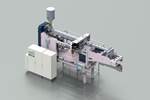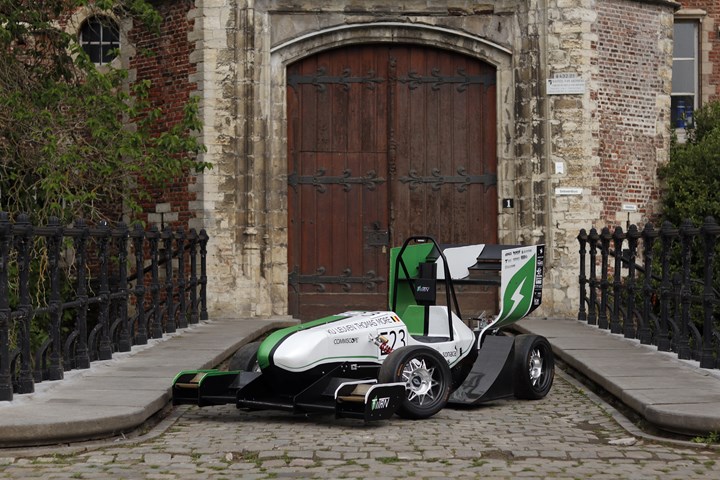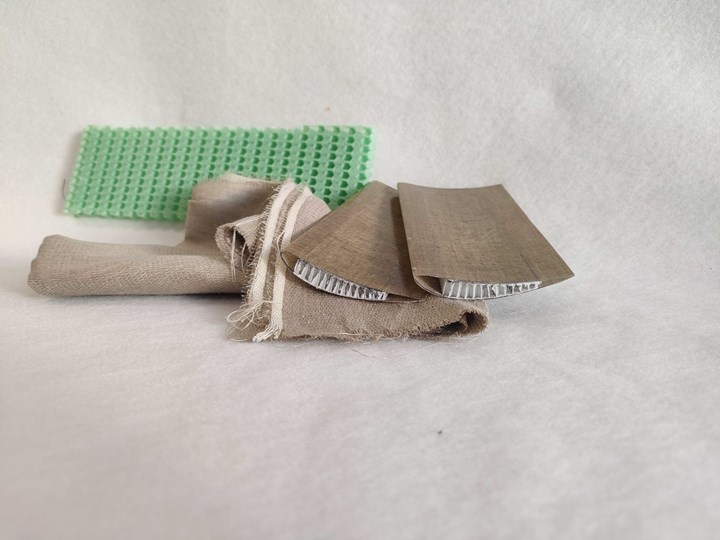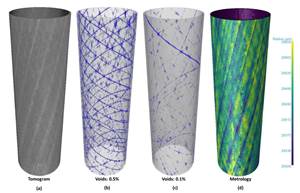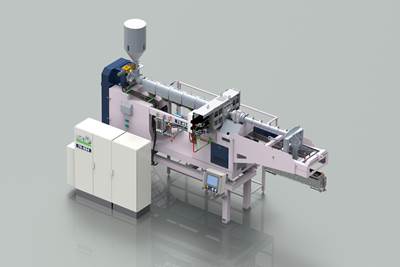Formula Electric Belgium's Titan race car features EconCore rPET honeycomb
Front wings and undertray comprise the honeycomb core material, the latter reducing wing weight by 26% compared to the previous year, and able to withstand forces 1,000 times its own weight.
EconCore’s (Leuven, Belgium) award-nominated recycled polyethylene terephthalate (rPET) honeycomb material is being harnessed by the Formula Electric Belgium team for the front wings and the entire undertray of their 220-kilogram (485-pound) Titan race car, which was unveiled on May 24, 2022.
Based on recycled PET material, the rPET honeycomb cores are made up of 100% recycled material, predominantly sourced from non-food post-consumer and industrial PET waste streams. Offering high mechanical performance, low weight and high temperature stability, EconCore says rPET is the material of choice for a range of applications, including motorsport.
The team of engineering students produced the front wing skin out of natural flax fiber. Last year, the team used carbon fiber-reinforced polymers (CFRP) for the skins of the wing profile, and required aluminum stiffeners —similar to those found in airplane wings — to give them greater stiffness. However, to adapt a more sustainable approach without compromising on performance, Formula Electric Belgium substituted the aluminum stiffeners with rPET honeycomb to produce a sandwich panel which was both lighter and more rigid.
The rPET cores were thermoformed. The Formula Electric Belgium team started with constant thickness to shape into the wing, using heated molds to press the core into shape. EconCore says the use of its technology reduced wing weight by 26% compared to the same-sized wing from the prior year, enabling the race car to go from 0-100 kilometers per hour in 2.5 seconds. The front wing component is also highly rigidity, capable of withstanding forces equivalent to almost 1000 times its own weight. The Titan race car has undergone multiple tests within its various stages of development; under a three-point bending test, the wing was capable of withstanding 46 kilograms (101 pounds) of force.
Throughout the development stages, EconCore says it opened up its doors to the Formula Electric Belgium team, enabling them to use the company’s testing equipment to evaluate the strength of the material, which proved crucial to the entire development process.
“With the rPET honeycomb core, Formula Electric Belgium were able to produce a highly rigid, lightweight front wing component which weighed in at only 50 grams,” Wouter Winant, technical manager at EconCore, says. “And at the same time this shows that achieving optimal performance is possible with sustainable materials. Our rPET honeycomb core technology is available to be licensed for a variety of applications and Formula Electric Belgium have perfectly demonstrated the material’s versatility.”
Formula Electric Belgium has been bringing together aspiring engineers from Belgium-based Katholieke Universiteit Leuven, UGent, UHasselt, UCLouvain and Thomas More University for the last 12 years. The program was initially set up to provide engineering students with a real-world working environment to grow their technical skills by building complete race cars every year to compete in the worldwide Formula Student competitions.
The next steps for the race car are to undergo testing and setup sessions prior to the first competitive race in the Netherlands in July, followed by further races in Hungary and Croatia in August. For the competitions themselves the Formula Electric Belgium team will put their race car through a range of dynamic and static events which they will be scored on. The dynamic events include acceleration, skid pad, autocross and endurance, while the static events are cost analysis, design analysis and business plan presentation. The competition isn’t only about how the cars perform but also the innovative approach that each team has undertaken in the design and manufacture of their vehicle.
“The rPET honeycomb core was an exciting and interesting material to work with and the entire EconCore team were enthusiastic in supporting us while we used their facilities,” Karel Van Wambeke, aerodynamics engineer at Formula Electric Belgium, emphasizes. “We can’t wait to put our hard work to the test and see how we perform in our first competition in the Netherlands in July.”
Related Content
Multi-scale 3D CT imaging enables digital twinning, high-fidelity simulation of composite structures
Computed tomography (CT) provides highly accurate 3D analysis of internal microstructure, performance simulation of carbon fiber/PEEK satellite strut.
Read MoreGenerative Orthoses project to reshape orthopedic care
CRP Technology, MHOX and Istituto Ortopedico Rizzoli, one of the winners of the WORTH Partnership Project II, have developed bespoke orthoses using generative design, Windform GT fiberglass materials and PBF.
Read MoreCarbon fiber/flax landing gear achieves 54% weight reduction via tailored layup optimization
Fuko’s Biogear showcases how strategic composite material distribution and natural fiber damping properties can lightweight and enhance critical aerospace structure performance.
Read MoreNext-gen fan blades: Hybrid twin RTM, printed sensors, laser shock disassembly
MORPHO project demonstrates blade with 20% faster RTM cure cycle, uses AI-based monitoring for improved maintenance/life cycle management and proves laser shock disassembly for recycling.
Read MoreRead Next
EconCore, ThermHex Waben optimize honeycomb core production
An investment in additional MEAF 75-H34 extruders reduce energy consumption in honeycomb production by up to 65% and double capacity.
Read MoreNext-gen fan blades: Hybrid twin RTM, printed sensors, laser shock disassembly
MORPHO project demonstrates blade with 20% faster RTM cure cycle, uses AI-based monitoring for improved maintenance/life cycle management and proves laser shock disassembly for recycling.
Read MoreUltrasonic welding for in-space manufacturing of CFRTP
Agile Ultrasonics and NASA trial robotic-compatible carbon fiber-reinforced thermoplastic ultrasonic welding technology for space structures.
Read More

